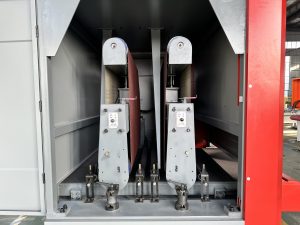Precision and surface quality are paramount in the manufacturing and metalworking industries. Whether in aerospace, automotive, or electronics, the performance and durability of metal parts rely heavily on how they are processed. One critical step in metal fabrication is deburring—removing rough edges, sharp protrusions, and imperfections from metal parts. Metal deburring equipment plays a vital role in enhancing components’ precision and surface quality. Let’s dive into how these tools work and their significance in modern manufacturing.
What is Metal Deburring?
Metal deburring refers to the process of removing unwanted material, also known as burrs, from a metal workpiece that forms during cutting, machining, grinding, or other manufacturing processes. Burrs are ragged edges left behind after a part is cut or machined, and they can lead to several issues, including safety hazards, poor aesthetics, and functional failure. Burrs can interfere with part assembly, cause damage to machinery, and compromise the strength of the part.
Deburring equipment helps streamline the removal of these imperfections, ensuring that the workpiece meets necessary quality standards. This technology ranges from manual tools to automated machines that handle high volumes of parts with greater efficiency and precision.
The Role of Metal Deburring Equipment in Enhancing Precision
Precision is essential in manufacturing, especially in industries like aerospace, automotive, and medical device production, where tight tolerances and flawless components are critical. Top metal deburring equipment improves precision in several ways:
1. Uniform Surface Treatment
Deburring machines ensure that every edge of a metal part is treated uniformly. In applications requiring consistency, such as component assembly, uneven surfaces or burrs can cause defects. Automated deburring ensures uniform treatment, leading to higher consistency compared to manual deburring.
2. Reduced Dimensional Variance
The precision of deburring equipment minimizes dimensional changes during the deburring process. Manual deburring can sometimes result in over-removal of material, causing parts to fall out of specification. Automated deburring reduces the risk of human error and maintains consistent dimensions.
3. Tighter Tolerances
Burrs that are not properly removed can affect the tight tolerances required in many industrial applications. For example, in the aerospace industry, improper fits between components due to burrs can lead to misalignment and malfunction. Automated deburring ensures burr removal in a controlled manner, helping parts meet strict tolerance requirements.
4. Improved Edge Quality
Deburring equipment refines edges to a smooth finish, crucial for parts that need to fit together precisely. A sharp or uneven edge can interfere with the assembly process, leading to defects. Deburring ensures smooth, clean edges, improving the overall precision of the part.
How Metal Deburring Equipment Enhances Surface Quality
Surface quality is another crucial factor in metalworking. Rough edges, burrs, and tool marks left behind during machining can affect the part’s appearance, corrosion resistance, and mechanical performance. Metal deburring equipment enhances surface quality by:
1. Eliminating Rough Edges and Tool Marks
Deburring removes rough edges and tool marks from metal parts, improving their visual appeal and structural integrity. Automated deburring ensures imperfections are consistently removed, resulting in a smooth, polished surface.
2. Enhanced Corrosion Resistance
Burrs and sharp edges are prone to trapping moisture, leading to corrosion over time. By removing burrs, industrial deburring equipment reduces the potential for corrosion, especially in harsh environments such as automotive or marine industries. A smooth, burr-free surface improves the metal’s resistance to oxidation.
3. Smoother Surface for Coatings and Finishes
Parts often undergo additional processes like coating, painting, or anodizing to enhance appearance or provide protective layers. A burr-free surface allows for an even application of finishes, improving adhesion and quality. Inconsistent surfaces can lead to issues like cracking, peeling, or bubbling in the final coating.
4. Better Fatigue Resistance
Burrs and rough edges act as stress concentrators, leading to cracks under pressure. Removing burrs and smoothing edges helps distribute stress evenly, reducing the likelihood of crack formation and improving the part’s fatigue resistance. This is critical in industries where parts are subjected to constant mechanical stress.
Types of Metal Deburring Equipment
Several types of metal deburring equipment cater to different materials, part sizes, and production needs. Common types include:
1. Manual Deburring Tools
Handheld tools like files, brushes, or rotary tools are ideal for small-scale operations or intricate shapes. While effective for low-volume jobs, they are time-consuming and less precise than automated methods.
2. Abrasive Deburring Machines
These machines use abrasive belts or brushes to remove burrs from parts. They’re versatile and handle a wide range of materials and part sizes. Abrasive deburring machines are ideal for medium to high-volume production.
3. Dry or Wet Tumbling Machines
Tumbling machines use abrasive media in a rotating drum to deburr parts. This method is suitable for small batch production or finishing parts with complex geometries, providing consistent results.
4. Robotic Deburring Systems
Robotic deburring systems utilize robotic arms to remove burrs with high precision. These automated systems can operate around the clock with minimal human intervention, ensuring high throughput and consistency in large-scale manufacturing.
5. Laser Deburring
Laser deburring uses high-energy lasers to vaporize burrs from parts. This technique is especially effective for delicate areas and offers a high level of precision without physical contact with the part.

Conclusion
Metal deburring equipment plays a crucial role in enhancing the precision and surface quality of metal parts. By removing burrs, rough edges, and tool marks, deburring machines ensure parts meet tolerance specifications, have a smooth finish, and perform optimally in their applications. As manufacturing processes become increasingly automated, deburring equipment remains integral to achieving high standards in industries like aerospace, automotive, and medical device production. Whether through abrasive machines, robotic systems, or lasers, deburring equipment improves efficiency, reduces defects, and ensures overall product quality.

